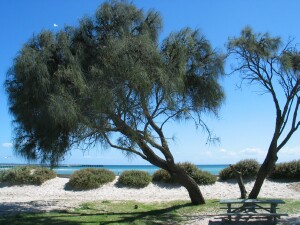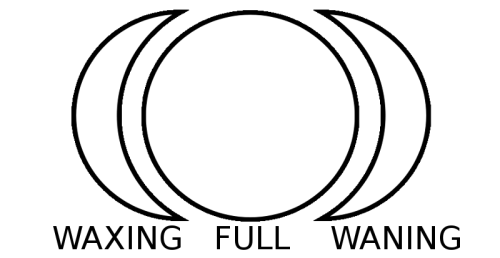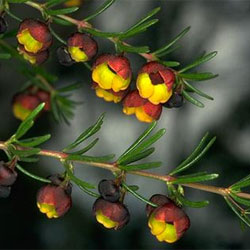[Today we welcome columnist Inga Leonora Westerberg. In January, The Wild Hunt said goodbye to Cosette Paneque as she ventured off to engage in new and exciting personal projects. However, while it is sad to see someone leave, it is also nice to welcome a new voice. Westerberg will become our new Australian writer within our monthly Around the World column. Today she introduces herself.]
Hello, good Wild Hunt readers! I’m pretty excited to be part of the team here at the Hunt, and particularly because I get to share all things Straya and Pagan – two of my most favourite things. I’ve been writing specifically about both for some time. Who needs another internet forum to do just that? Inga does!

Drooping She-oak Photo A J Brown (Courtesy Photo)
Before doing that, I want to take a moment to send some love to the wonderful Cosette Paneque, the former Australian “Around the World” contributing writer. Cosette’s stepping down from this role has left me with some big shoes to fill. I enjoyed her posts, not only because she is a talented and insightful writer, but also because she offered a unique perspective on the Australian Pagan community having lived and participated in such communities in the U.S. An outside-the-box perspective is always welcome.
As Cosette moves forward on her personal journey, I wish her every blessing and send many thanks for her contributions here and for the conversations generated inside the broader Australian Pagan community.
It is fair to say that Aussie Pagans can be a bit of a strange lot. Probably because we start everything upside down and backwards. While the majority of TWH readers have just come from Imbolc (Candlemas) celebrations, we’re hot on the back of Lughnasadh (Lammas) and the weather in February is the usual melting high summer, bushfires and a little less harvest.
Here in fair Hobart Town, we’re experiencing lovely 25+°C (77°F) days, which is sort of laughable to the rest of the country as the mainland braces for the coming days tipping 40°C (104°F). The difference does not aid me with my current sunburn after a weekend in the north of the Tasmania in Launceston. This has something to do with our proximity to the hole in the Ozone Layer over Antarctica. No Australians are safe!
Australian poet Dorothea Mackellar said it best when she wrote: “I love a sunburnt country.” That is probably also the most well-known line from her celebrated poem ‘My Country,’ first published when she was in England in 1908. But it is the lesser-known lines that have always spoken to me particularly.
The love of field and coppice,
Of green and shaded lanes.
Of ordered woods and gardens
Is running in your veins,
Strong love of grey-blue distance
Brown streams and soft dim skies
I know but cannot share it,
My love is otherwise.
Australian Pagans are for the most part European, chiefly British descendants. Our country has a difficult history and our Land an Ancient Spirit that has often felt veiled, inaccessible, if not seemingly non-existent to us. There are no Gum trees in the old myths and, at times, our seasonal celebrations feel almost comical atop the Australian landscape.
What is a Pagan to do whose veins run with violent bush and chaotic eucalyptus?
Such was Mackeller’s love, and my own. Simply “flipping the Wheel” does not suit for a continent with five, six, and seven seasons, all of which refuse adamantly to comply with the imposed European order. Australian Pagans of all ilks are slowly coming to a new place. Throwing the old ways to the elements and picking up the pieces in lopsided, strange new combinations, and devoting themselves to learning the new world order as they see revealed here. Some even are turning to Indigenous wisdom to gain better insight.

Triple Goddess Symbol as it would look in Australia
It is tough work. Any new person coming to the internet seeking Pagan ways will learn very quickly about all things Northern Hemisphere. Nowhere on the lists of planetary, elemental, and seasonal correspondences will you find She-oak (Casuarina and Allocasuarina var.) or Silver Wattle (Acacia dealbata). There are no writings on the magical uses for Waratah (Telopea) and Boronia.
The Sun is at its height in the South and moves North toward our Winter Solstice. Even the classical representation of the Triple Goddess is backward, reading as waning, full and waxing to an Australian eye. Slowly, the beginnings of a new corpus of wisdom are being formed – one that is inherently syncretic and unique.
Those of us who do this work are not necessarily able to be aided by others doing the same. Why? Australia is not simply a country. It is a continent and, from one side to the other, from Hobart to Darwin, there is every possible environment and season. Something as simple as the correspondence between elements and the compass points are finding increased variety. For example, in Perth, the Indian Ocean lies to the west with the land to the east. But for those people in the temperate southeast, it is the directions of south and east that herald the cool ocean breezes over the Tasman Sea and the great expanse of land reaches off into the West.

Boronia megastigma (Source)
Additionally, from the Indian to Pacific, there are very few of us. At the last census in 2011, 32,083 Australians identified as Pagan. Distance really is a tyranny for many Pagans around the country. So we take to the internet. Our gatherings, covens and groves can be small, but online we can share across far-flung places. And, those who are the most isolated by distance can connect.
Within those small gatherings and covens and groves, new liturgy and rituals are being written. Animists like myself are invoking the spirits of the Sentinal Gums to guard our circles, calling on the Spirit of the Boronia in our spellcraft for love, switching out Pepper for Mountain Pepper Berries (Tasmannia lanceolata), and offering our Ancestors Silver Wattle resin in the censor.
To date, that subject has been the focus of my writing on my own blog Australis Incognita, and some of what I hope to share with you here. The kind of Paganisms for which there are no guides, no lists, and no books. The kind of Paganisms that are very new, with the majority of us identifying as Wiccan, and yet, older than even we realise as strange Old World habits are revealed in the walls of early colonial buildings. Paganisms that enter into Indigenous stories that are 60,000 years old, seeing them with new eyes.
What’s going on right now?
A few of us are feeling a bit jealous of those in Los Angeles who got to see Kenneth Anger’s Lucifer Brothers Workshop at Art Los Angeles Contemporary in January which included two works by our very own Rosaleen “Roie” Norton, spiritual ancestor to many an Australian Witch.
On the last weekend of January in Tasmania, the Tasmanian Pagan Alliance held their annual Harvest Fest in the North West of the State, which was by all accounts a fabulous event. The following weekends also saw a collection of events as Pagans gather across the country to celebrate high summer harvests, which is all cherries and mangos.
At MONA (Museum of Old and New Art) in Hobart, Devil’s Kitchen Curios made their debut at MoMa the museum’s summer markets, showcasing hand made Occult curios. MONA has been a huge addition to the Hobart cultural scene and, even more fabulous, their left-of-centre thinking means some of our local witches and covens get to share their wares at one of the largest cultural attractions in the State. Devil’s Kitchen Curios will be at MoMa next on Feb. 28, Mar. 13 and Mar. 27.
As for me, I’ve just come from celebrating the wedding of one of my own students, having the happy role of offering the blessing in the ceremony. I handmade rattles of wattle, gumnuts and sea shells for each of the guests, and our Pagan friends from across the state helped me drum. The sound of them all together as our bride skipped down the aisle was a magical moment I will not soon forget. We called on Lutruwitta, as She is called by our Indigenous kin in Palawa-kani, the Spirit of our Land, manifest in the elements. Our motifs for the celebration were the Great Gums and Banksia, both protective plants, the flowers of each rich with nectar. Perfect for our newlywed couple. And this is just another example of how our unique Land is informing our rites and rituals.
In the meantime, I’m going to leave you with a bit of true Australiana. ‘Waltzing Matilda‘ was written by A.B. ‘Banjo’ Paterson at old Dagworth Homestead, Queensland in January 1895. Here it is sung by Ali Mills in Top End Kriol, a combination of languages said to have grown organically from the meeting of Aboriginal, European and Chinese people around Darwin.
At one time ‘Waltzing Matilda‘ was considered for our national anthem, because stealing sheep, anti-establishment sentiments, and ghost haunted billabongs is what we do. Aussies are a bit awesome like that.
I’m going to squeeze in as many anti-establishment sentiments and ghost-haunted billabongs as I possibly can as I share with you the crazy joys of Paganism in Australia. I’ll be honest with you though, there’s probably not going to be a great deal of sheep theft.
The Wild Hunt is not responsible for links to external content.
To join a conversation on this post:
Visit our The Wild Hunt subreddit! Point your favorite browser to https://www.reddit.com/r/The_Wild_Hunt_News/, then click “JOIN”. Make sure to click the bell, too, to be notified of new articles posted to our subreddit.
Welcome 🙂 Sounds like you’ll be adding some much needed Southern Hemisphere perspective!
“Here in fair Hobart Town, we’re experiencing lovely 25+°C (77°F) days, which is sort of laughable to the rest of the country as the mainland braces for the coming days tipping 40°C (140°F).”
I do believe you need to switch the 4 and 0 in 140°F. 140°F would be 60°C.
Yes. Thank you. The error was corrected.
Hail and welcome, Inga! I look forward to reading more from your Aussie perspective. Greetings from Oregon, USA.